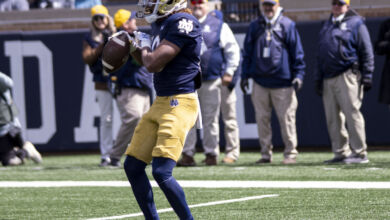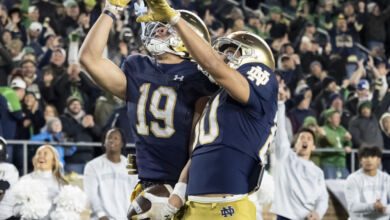
While there is no shortage of talent in the upper-class wide receiver ranks for Notre Dame, there has been quite the shortage of productivity. Collectively, the 2017-2019 Notre Dame wide receiver recruiting classes has produced at a level that is dramatically low in the recent history of Notre Dame football. Individually, the production 2017-2019 recruits are as follows:
| Name | Class | Receptions | Yards | Touchdowns |
| Michael Young | 2017 | 18 | 181 | 2 |
| Jafar Armstrong | 2017 | 30 | 294 | 0 |
| Micah Jones | 2018 | 0 | 0 | 0 |
| Kevin Austin | 2018 | 6 | 108 | 0 |
| Lawrence Keys | 2018 | 18 | 185 | 0 |
| Braden Lenzy | 2018 | 18 | 317 | 3 |
| Joe Wilkins Jr. | 2018 | 7 | 63 | 1 |
| Kendall Abdur-Rahman | 2019 | 0 | 0 | 0 |
| Avery Davis | 2019 | 39 | 476 | 4 |
While these numbers are strikingly low, what is even more pronounced is how these three recruiting classes compare with the last ten sets of three-year wide receiver recruiting classes that preceded them:
As is seen above, the 2017-2019 recruiting classes’ production in terms of receptions, yards, and touchdowns is a small fraction of every single one of the ten previous three-year wide-receiver recruiting classes. This lack of productivity coupled with highly talented 2020 and 2021 wide-receiver recruiting classes has led many to call on Brian Kelly to play the youngsters. However, it is clear from Brian Kelly’s comments this spring that it is the 2017-2019 recruiting classes that will be depended upon for productivity at the wide receiver position.
Remaining from the 2017-2019 wide receiver recruiting classes are graduate student Avery Davis and seniors Kevin Austin, Braden Lenzy, Lawrence Keys, and Joe Wilkins. Of this group, Kevin Austin was the highest-ranked recruit and has always possessed great potential. Had injuries not sidelined him he would likely have been a multiple-year starter. Currently injured this spring, the potential and excitement around his possible return remains despite the repeated injuries he has sustained.
Lenzy and Keys have the speed and raw athleticism to be explosive. Lenzy has flashed that in the relatively few chances he has had and likely would have started opposite Austin last season had injuries not sidelined him as well. Both Lenzy and Keys (who has also battled injuries) have shown a greater commitment in the weight room this winter. Joe Wilkins Jr. has the length and talent to produce at the high level Notre Dame will require and has impressed this spring. Davis, the quarterback-turned-cornerback-turned-running back-turned-wide receiver is the unlikely leader of this group in all ways including productivity.
The Notre Dame offense will look to be more explosive and dynamic in 2021 as it continues to narrow the gap between themselves and the championship-winning teams. It is clear from spring practices that it is this veteran group of receivers who will be given their opportunity to provide this explosiveness, and with the recent departure of rising sophomore 5* recruit Jordan Johnson, it is more important than ever that they do.
Whether this group is able to produce to the level at which they are capable and which Notre Dame requires to compete for national championships is yet to be seen. However, with a talented group of underclassmen wide receivers ready to see the field and the lack of productivity from the upperclassmen thus far, it is clear that this will be their last chance.



